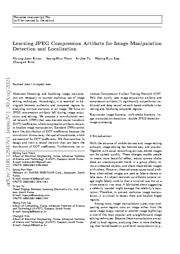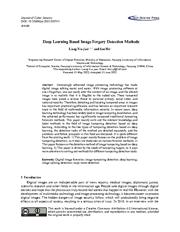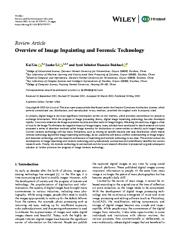A copy of this work was available on the public web and has been preserved in the Wayback Machine. The capture dates from 2022; you can also visit the original URL.
The file type is application/pdf.
Filters
An Adaptive Neural Network for Unsupervised Mosaic Consistency Analysis in Image Forensics
2020
2020 IEEE/CVF Conference on Computer Vision and Pattern Recognition (CVPR)
Automatically finding suspicious regions in a potentially forged image by splicing, inpainting or copy-move remains a widely open problem. ...
Blind detection neural networks trained on benchmark data are flourishing. Yet, these methods do not provide an explanation of their detections. ...
Discussion We have shown that a small convolutional neural network could be used to accurately detect and interpret CFA artefacts, and subsequently use them to detect forgeries in images. ...
doi:10.1109/cvpr42600.2020.01420
dblp:conf/cvpr/BammeyGM20
fatcat:ho44uvzu5jh5dcxicawk5zzx4m
Multi-Supervised Encoder-Decoder for Image Forgery Localization
2021
Electronics
Unlike many existing solutions, we employ a semantic segmentation network, named Multi-Supervised Encoder–Decoder (MSED), for the detection and localization of forgery images with arbitrary sizes and multiple ...
Image manipulation localization is one of the most challenging tasks because it pays more attention to tampering artifacts than to image content, which suggests that richer features need to be learned. ...
As illustrated in Figure 2 , the encoder adopts a Deep Convolutional Neural Network to encode the input, while the decoder restores partial pixels to amplify the encoded feature map using upsampling, ...
doi:10.3390/electronics10182255
fatcat:6wwiaphbcnexrh7hjjwrcqy6nq
AHP validated literature review of forgery type dependent passive image forgery detection with explainable AI
2021
International Journal of Power Electronics and Drive Systems (IJPEDS)
In the recent decade, a tremendous increase in image information generation is happening due to the massive use of social networking services. ...
Nowadays, a lot of significance is given to what we read today: newspapers, magazines, news channels, and internet media, such as leading social networking sites like Facebook, Instagram, and Twitter. ...
In this work [11] , CNN based methods are used for handling copy move forgery detection. CNN with CFA (color filter array) features are used for finding and localizing the manipulated region. ...
doi:10.11591/ijece.v11i5.pp4489-4501
fatcat:jfxrbki7d5bjpb2i7fhn6e53fm
Learning JPEG Compression Artifacts for Image Manipulation Detection and Localization
[article]
2021
arXiv
pre-print
We propose a convolutional neural network (CNN) that uses discrete cosine transform (DCT) coefficients, where compression artifacts remain, to localize image manipulation. ...
It significantly outperforms traditional and deep neural network-based methods in detecting and localizing tampered regions. ...
COV-ERAGE (Wen et al., 2016) contains copy-move images designed to counter a similarity-based copy-move forgery detector. ...
arXiv:2108.12947v1
fatcat:cscerhw2rreubob7tvos7jgvhq
MFAN: Multi-Level Features Attention Network for Fake Certificate Image Detection
2022
Entropy
In the decoder module, the attentive feature maps are convoluted and unsampled to effectively generate the prediction mask. ...
To tackle this task, a novel method called Multi-level Feature Attention Network (MFAN) is proposed. MFAN is built following the encoder–decoder network structure. ...
Image Forgery Detection and Localization Copy-move: A common pipeline for copy-move forgery detection algorithms has three essential stages: feature extraction, matching and post-processing. ...
doi:10.3390/e24010118
pmid:35052144
pmcid:PMC8774785
fatcat:ud7y3632rne47idcenwdohi564
Two-stream Encoder-Decoder Network for Localizing Image Forgeries
[article]
2020
arXiv
pre-print
This paper proposes a novel two-stream encoder-decoder network, which utilizes both the high-level and the low-level image features for precisely localizing forged regions in a manipulated image. ...
The dense feature maps of the two streams are concatenated and fed to a final convolutional layer with sigmoidal activation to produce pixel-wise prediction. ...
CONCLUSIONS This paper proposed a novel two-stream encoder-decoder network for localizing different types of forgeries, namely splicing, copy-move, and content-removal. ...
arXiv:2009.12881v1
fatcat:cfxwonggibe2rds5crcl2x3fie
IFLNET: Image Forgery Localization Using Dual Attention Network
2022
International Journal of Intelligent Engineering and Systems
This network contains self-attention modules that contribute to extracting and matching features in the channel and spatial domains. ...
This experimental study uses typical datasets such as CASIA V1.0, CASIA V2.0, and Columbia. ...
Related works Copy-move and splicing have been the mass widely used forgery methods. ...
doi:10.22266/ijies2022.1231.17
fatcat:7trs2qd23fhahhdwxxifofavd4
Non-Semantic Evaluation of Image Forensics Tools: Methodology and Database
[article]
2021
arXiv
pre-print
This methodology creates automatically forged images that are challenging to detect for forensic tools and overcomes the problem of creating convincing semantic forgeries. ...
Based on this methodology, we create the Trace database and conduct an evaluation of the main state-of-the-art image forensics tools. ...
The decision is made jointly for JPEG and CFA, as the CFA and JPEG Grid datasets mimic artefacts commonly found in internal copy-move forgeries, whereas the CFA Algorithm and JPEG Quality datasets represent ...
arXiv:2105.02700v1
fatcat:34woyuwk2veqnaeuggvqyulmta
Semantic Modeling and Pixel Discrimination for Image Manipulation Detection
2022
Security and Communication Networks
Specifically, the pixel-level detection branch resamples features and uses an LSTM to detect manipulations, such as resampling, rotation, and cropping. ...
Image manipulation methods, such as the copy-move, splicing, and removal methods, have become increasingly mature and changed the common perception of "seeing is believing." ...
[3] propose a parallel deep neural network scheme BusterNet for image copy-move forgery localization. ...
doi:10.1155/2022/9755509
fatcat:igf4spljqng7zbbfkffgfhi2c4
TransForensics: Image Forgery Localization with Dense Self-Attention
[article]
2021
arXiv
pre-print
The former is to model global context and all pairwise interactions between local patches at different scales, while the latter is used for improving the transparency of the hidden layers and correcting ...
To tackle this challenging problem, we introduce TransForensics, a novel image forgery localization method inspired by Transformers. ...
Firstly, we use a fully convolutional network (FCN) as backbone for feature extraction. ...
arXiv:2108.03871v1
fatcat:r2bzn53ptbhsbg4d4bo5w2zobq
Deep Learning Based Image Forgery Detection Methods
2022
Journal of Cyber Security
In recent years, deep learning technology has been widely used in image tampering localization, and the achieved performance has significantly surpassed traditional tampering forensics methods. ...
Therefore, detecting and locating tampered areas in images has important practical significance, and has become an important research topic in the field of multimedia information security. ...
[65] proposed a copy-paste detection method based on convolutional neural network. ...
doi:10.32604/jcs.2022.032915
fatcat:jneg3xibm5daxnra66f4y2ccpm
Overview of Image Inpainting and Forensic Technology
2022
Security and Communication Networks
So far, academia still lacks a unified understanding of image forgery and detection technology, and the research architecture of inpainting and forensic technology is not clear. ...
Current forensic technology still has many limitations, such as relying on specific features and data distribution which makes forensic technology lag behind image inpainting technology. ...
[134] proposed using a dense network structure to solve the problem of copy-move forgery detection and location. ...
doi:10.1155/2022/9291971
doaj:9085f6d15bc64d13acd70f636181bf23
fatcat:pg5ncxzngjblzl42bstp3ykxpi
Image Forgery Detection Using Tamper-Guided Dual Self-Attention Network with Multiresolution Hybrid Feature
2022
Security and Communication Networks
To address this problem, we propose an end-to-end fully convolutional neural network. ...
Extensive experiments demonstrate that compared to existing schemes, our scheme can simultaneously effectively achieve pixel-level forgery localization and image-level forgery detection while maintaining ...
(is paper designs an end-to-end fully convolutional neural network to detect and localize tampered regions. ...
doi:10.1155/2022/1090307
fatcat:47d4mu7fjffgrdpbqhhd2xwawe
Developing an Image Manipulation Detection Algorithm Based on Edge Detection and Faster R-CNN
2019
Symmetry
Finally, Region Proposal Network (RPN) was used to locate forgery regions. ...
Therefore, an image manipulation detection algorithm leveraged by the Faster Region-based Convolutional Neural Network (Faster R-CNN) model combined with edge detection was proposed in this paper. ...
Our algorithm performs well in Copy-Move Forgery Detection (CMFD) and image splicing detection. ...
doi:10.3390/sym11101223
fatcat:4g7njhixibhlnaqugj22x2luee
Self-Adversarial Training incorporating Forgery Attention for Image Forgery Localization
[article]
2022
arXiv
pre-print
Hence the detection and localization of these forgeries become quite necessary and challenging. ...
In this paper, we propose a self-adversarial training strategy and a reliable coarse-to-fine network that utilizes a self-attention mechanism to localize forged regions in forgery images. ...
Recently, the deep-learning based methods [13] , [11] , [4] , [14] have demonstrated superior performance by using convolutional neural networks. ...
arXiv:2107.02434v2
fatcat:24mrd4ripbelxkmey5ryxqv7gq
« Previous
Showing results 1 — 15 out of 72 results














